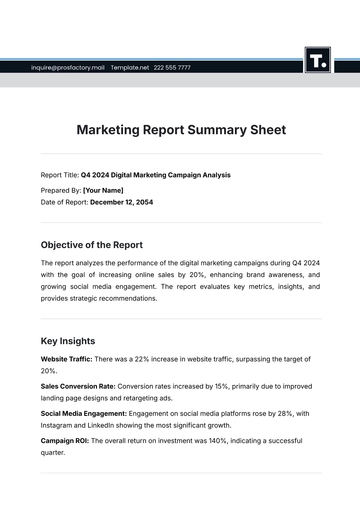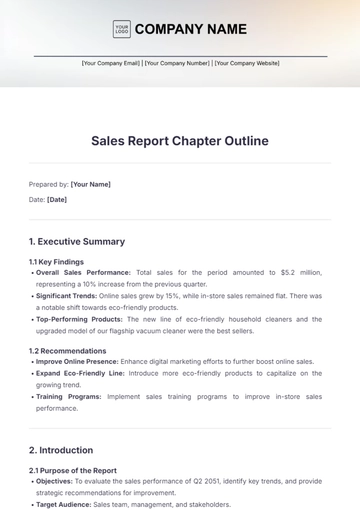Free Car Rental Marketing Report

I. Executive Summary
A. Overview of the Car Rental Industry
The global car rental industry continues to expand, driven by increasing urbanization, business travel, and a growing preference for rental services over vehicle ownership, especially in urban areas. Technological advancements such as mobile apps for bookings and keyless entry systems are reshaping customer expectations and service delivery.
B. Summary of Key Findings and Recommendations
This report identifies key trends such as the shift towards electric and hybrid vehicles, the importance of sustainability in fleet management, and the rising influence of digital platforms in customer acquisition. Recommendations include leveraging data analytics for personalized marketing strategies, enhancing customer service through AI-driven solutions, and expanding into emerging markets with high demand for rental services.
II. Introduction
A. Purpose and Scope of the Report
The purpose of this report is to analyze [Your Company Name]'s marketing strategies within the broader context of the car rental industry. It aims to provide insights into market dynamics, competitor strategies, and customer preferences to optimize marketing effectiveness and drive growth.
B. Methodology and Data Sources
This report utilizes a combination of primary research, including customer surveys and focus groups, and secondary research from industry reports, market studies, and competitor analyses. Data collection methods ensure a comprehensive and reliable assessment of market trends and consumer behavior.
III. Market Analysis
A. Market Overview
Size and Growth Rate of the Car Rental Market
The global car rental market was valued at approximately $[00] billion in [Year] and is projected to grow at a compound annual growth rate (CAGR) of [00]% over the next five years. This growth is fueled by increasing travel for business and leisure, urbanization trends, and a preference among millennials for flexible mobility solutions.
Key Trends and Developments
The incorporation of advanced smart technologies into modern vehicles, including features like GPS navigation systems and seamless in-car connectivity, significantly improves the overall convenience for drivers and passengers. Additionally, it enhances the operational efficiency of the vehicles, making daily commutes and long journeys more manageable and productive.
Due to the increasing demand for environmentally friendly alternatives, car rental companies are prompted to broaden their vehicle offerings. This expansion includes integrating electric and hybrid vehicles into their fleets. By doing so, these businesses are aiming to attract and cater to consumers who prioritize environmental sustainability and are conscious of their ecological impact.
B. Competitive Landscape
Analysis of Major Competitors
[Your Company Name] finds itself competing with well-established industry leaders such as [Competitor A] and [Competitor B]. These competitors have earned recognition and respect for their comprehensive network of rental locations, a wide array of vehicle options, and a robust and highly visible brand presence. To set themselves apart in the competitive landscape, these companies leverage various strategic initiatives. They offer loyalty programs designed to reward recurring customers, form exclusive partnerships with leading airlines and hotels, and constantly innovate their service offerings to meet and exceed customer expectations.
Competitor Strategies and Market Positioning
[Competitor A] places a significant emphasis on providing premium customer service and offering loyalty rewards as key strategies to maintain and grow a dedicated customer base. On the other hand, [Competitor B] prioritizes affordability and the diversification of its fleet, aiming to attract a broad range of customers through cost-effective options and varied vehicle choices. By carefully analyzing and understanding the distinct strategies employed by these competitors, [Your Company Name] can take informed steps to refine its own marketing approach. This, in turn, can enhance the ability to attract new customers and retain existing ones, thereby thriving in a competitive market landscape.
IV. Customer Insights
A. Customer Demographics
Age, Gender, Income Levels, etc.
The customer base of [Your Company Name] primarily includes adults who are between the ages of 25 and 45. This demographic is evenly divided between male and female renters.
The majority of our customer base consists of individuals who have a moderate to high level of disposable income, indicating a general openness and readiness to invest in convenience and premium-quality services. This demographic values flexible rental agreements and vehicle choices, preferring tailored solutions that adapt to their diverse and changing travel needs.
B. Customer Preferences and Behaviors
Rental Duration, Vehicle Preferences, Booking Channels, etc.
[Your Company Name]'s customers frequently opt for short-term rental properties when planning their business trips as well as weekend getaways, indicating a significant trend in their preferences for these types of accommodations.
Sport Utility Vehicles (SUVs) and sedans are the types of vehicles that are most favored, primarily selected for their combination of comfort and practicality, which makes them highly suitable for use during travel.
Many people prefer using online booking platforms and mobile applications because of their simplicity and ease of access, which, in turn, significantly contributes to the large number of reservations being made through these digital channels.
C. Customer Feedback and Satisfaction
Analysis of Customer Reviews and Surveys
Customer satisfaction surveys conducted over time have consistently highlighted a trend of positive feedback from customers. Specifically, customers have frequently expressed their satisfaction with the cleanliness of the vehicles they rented. Additionally, there is a significant amount of praise directed towards the professionalism exhibited by the staff. Taken together, these positive remarks contribute to an overall rental experience that is favorably reviewed by a majority of those who participated in the surveys.
There are several areas in which improvements can be made, including the enhancement of transparency in pricing policies and the reduction of wait times during peak travel seasons. By implementing clearer communication channels for customers, overall satisfaction could be further enhanced.
V. Marketing Strategy
A. Current Marketing Initiatives
Advertising Campaigns
[Your Company Name] strategically employs highly focused digital advertising initiatives on various prominent online platforms. These efforts encompass the use of Google Ads, which allows for precise search engine marketing, as well as harnessing the power of widely used social media networks, including Facebook and Instagram, to reach specific audience segments.
Traditional advertising includes partnerships with travel agencies and promotional events at local business expos. These efforts aim to maintain visibility and attract diverse customer segments.
Digital Marketing
The website belonging to the company has been meticulously enhanced to be fully optimized for Search Engine Optimization (SEO). This optimization aims to bolster the company's organic search rankings, thereby improving the website's position in search engine results. As a result, this strategic effort is expected to significantly enhance the company’s online visibility and presence across various search platforms.
Email marketing campaigns are tailored to customer segments, offering personalized promotions and loyalty rewards. Automated follow-ups after rentals could further enhance customer engagement and loyalty.
Promotions and Discounts
To encourage repeat business and to attract new customers, especially during times when business activity is typically slower, a variety of seasonal promotions as well as discount codes are made available. These promotional efforts serve multiple purposes: they incentivize existing customers to make additional purchases and they also entice potential customers to engage with the business for the first time, thereby boosting sales and customer engagement during off-peak periods.
Special discounts are provided for corporate clients and long-term rentals to enhance customer retention. Analyzing the effectiveness of these promotions through customer data could inform future strategies.
B. Evaluation of Marketing Channels
Effectiveness and ROI of Each Channel
One of the most prominent features of digital marketing channels is their ability to consistently deliver a high return on investment (ROI). Among these various channels, Google Ads stands out as exceptionally effective, as it not only generates a significant number of leads but also results in numerous bookings. This level of performance highlights the efficacy of leveraging digital marketing strategies to achieve substantial business growth and engagement.
Social media engagement metrics show strong brand awareness and customer engagement, contributing to customer acquisition efforts. Tracking customer journey from awareness to booking could provide deeper insights into channel performance.
Customer Acquisition Cost Analysis
Cost per acquisition (CPA) metrics indicate that digital channels have a lower CPA compared to traditional advertising methods, demonstrating cost-effectiveness and efficiency in reaching target audiences.
If [Your Company Name] were to implement A/B testing alongside attribution modeling, it could lead to a more precise refinement of budget allocation strategies. This, in turn, holds the potential to significantly maximize the return on marketing investment (ROMI) for the company.
VI. SWOT Analysis
A. Strengths
Strong Brand Reputation: [Your Company Name] is well-regarded for its reliable service and diverse fleet, which includes eco-friendly vehicle options.
Customer Loyalty: High customer satisfaction and repeat business indicate a loyal customer base that values the company's service quality.
Strategic Location: Prime locations near airports and popular tourist destinations enhance accessibility and customer convenience.
B. Weaknesses
Seasonal Demand Fluctuations: Dependency on seasonal travel patterns results in revenue fluctuations and operational challenges during off-peak periods.
Limited Geographic Presence: Compared to competitors, [Your Company Name] may have a smaller footprint in certain geographic regions, limiting market reach and potential customer base.
C. Opportunities
Expansion into Emerging Markets: Exploring opportunities in emerging markets in Asia-Pacific and Latin America could tap into growing demand for rental services.
Enhanced Sustainability Initiatives: Partnering with electric vehicle manufacturers or integrating more eco-friendly options into the fleet can attract environmentally conscious consumers.
D. Threats
Intense Competition: The car rental industry is highly competitive with numerous players, including traditional companies and new entrants from the sharing economy.
Economic Uncertainty: Economic downturns or fluctuations in travel budgets could impact consumer spending on rental services, affecting revenue and profitability.
VII. Sales Performance
A. Revenue Generation Analysis
Sales Trends and Patterns
Quarterly sales data reveals peaks during summer and holiday seasons, driven by increased tourist activity and business travel.
Off-peak periods see lower booking volumes, prompting strategic pricing and promotional efforts to stimulate demand.
Seasonal Variations
Analysis of rental bookings during peak and off-peak seasons highlights opportunities for dynamic pricing strategies and targeted marketing campaigns.
Implementing flexible pricing models and customized promotions could optimize revenue generation throughout the year.
B. Impact of Marketing Activities on Sales
Marketing campaigns coincide with spikes in booking volumes, indicating a positive correlation between promotional efforts and revenue generation.
Customer retention rates show improvement due to targeted marketing initiatives and enhanced customer engagement strategies, contributing to sustained revenue growth.
VIII. Recommendations
A. Strategic Recommendations for Enhancing Marketing Effectiveness
Targeting New Customer Segments
Expand marketing efforts to attract millennials and business travelers through personalized offers and enhanced digital experiences.
Develop partnerships with travel influencers and online travel agencies to broaden brand awareness and reach.
Improving Customer Retention Strategies
Implement a customer loyalty program with tiered benefits and exclusive rewards for repeat renters.
Enhance post-rental communication to solicit feedback and address customer concerns promptly, fostering long-term relationships.
B. Opportunities for Growth and Expansion
New Markets or Geographic Areas
Explore opportunities in emerging markets where demand for rental services is on the rise.
Establish strategic alliances with local transportation providers to offer integrated travel solutions and enhance market penetration.
Partnerships and Collaborations
Form partnerships with eco-conscious brands or electric vehicle manufacturers to offer sustainable mobility options.
Collaborate with hospitality industry leaders to create bundled travel packages that include car rental services, catering to diverse customer preferences.
IX. Conclusion
A. Summary of Key Insights
[Insert Your Company Name Here] is excellently poised to take full advantage of growth opportunities in the ever-changing and dynamic car rental market. This will be achieved through the implementation of carefully planned and strategic marketing initiatives, coupled with approaches that center on providing an exceptional experience for our customers.
A sustained commitment to investing in digital marketing strategies, initiatives aimed at enhancing sustainability, and robust customer loyalty programs will serve as fundamental drivers of future success and ongoing market competitiveness.
B. Future Outlook for the Car Rental Market
The car rental industry is on the cusp of experiencing sustained growth in the future, which is largely influenced by a combination of significant technological advancements, changing consumer preferences, and overarching trends in global travel patterns.
In order for [Your Company Name] to preserve its position of leadership and ensure continued growth within a highly competitive market environment, it will be crucial to adapt to the ever-changing dynamics of the market and to take full advantage of emerging opportunities. By staying attuned to shifting trends and being proactive in identifying and capitalizing on new prospects, [Your Company Name] can navigate the complexities of the industry effectively, thereby maintaining its competitive edge and securing its long-term success.
- 100% Customizable, free editor
- Access 1 Million+ Templates, photo’s & graphics
- Download or share as a template
- Click and replace photos, graphics, text, backgrounds
- Resize, crop, AI write & more
- Access advanced editor
Enhance your car rental business strategy with the customizable Car Rental Marketing Report Template from Template.net. This editable template offers comprehensive sections on market analysis, customer insights, and strategic recommendations. Utilize the AI Editor Tool to tailor insights to your company’s needs, ensuring a data-driven approach for optimizing marketing effectiveness and achieving competitive edge.
You may also like
- Sales Report
- Daily Report
- Project Report
- Business Report
- Weekly Report
- Incident Report
- Annual Report
- Report Layout
- Report Design
- Progress Report
- Marketing Report
- Company Report
- Monthly Report
- Audit Report
- Status Report
- School Report
- Reports Hr
- Management Report
- Project Status Report
- Handover Report
- Health And Safety Report
- Restaurant Report
- Construction Report
- Research Report
- Evaluation Report
- Investigation Report
- Employee Report
- Advertising Report
- Weekly Status Report
- Project Management Report
- Finance Report
- Service Report
- Technical Report
- Meeting Report
- Quarterly Report
- Inspection Report
- Medical Report
- Test Report
- Summary Report
- Inventory Report
- Valuation Report
- Operations Report
- Payroll Report
- Training Report
- Job Report
- Case Report
- Performance Report
- Board Report
- Internal Audit Report
- Student Report
- Monthly Management Report
- Small Business Report
- Accident Report
- Call Center Report
- Activity Report
- IT and Software Report
- Internship Report
- Visit Report
- Product Report
- Book Report
- Property Report
- Recruitment Report
- University Report
- Event Report
- SEO Report
- Conference Report
- Narrative Report
- Nursing Home Report
- Preschool Report
- Call Report
- Customer Report
- Employee Incident Report
- Accomplishment Report
- Social Media Report
- Work From Home Report
- Security Report
- Damage Report
- Quality Report
- Internal Report
- Nurse Report
- Real Estate Report
- Hotel Report
- Equipment Report
- Credit Report
- Field Report
- Non Profit Report
- Maintenance Report
- News Report
- Survey Report
- Executive Report
- Law Firm Report
- Advertising Agency Report
- Interior Design Report
- Travel Agency Report
- Stock Report
- Salon Report
- Bug Report
- Workplace Report
- Action Report
- Investor Report
- Cleaning Services Report
- Consulting Report
- Freelancer Report
- Site Visit Report
- Trip Report
- Classroom Observation Report
- Vehicle Report
- Final Report
- Software Report





























